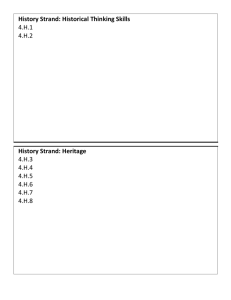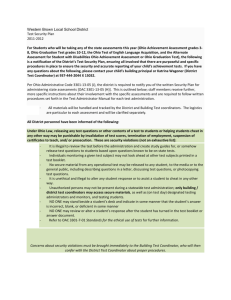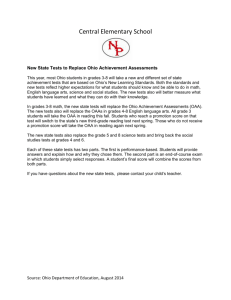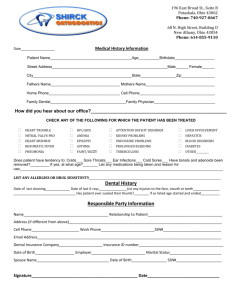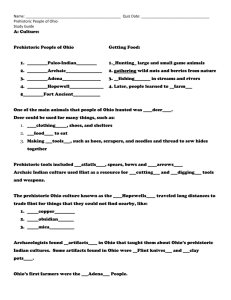SS Learning Outcome
advertisement
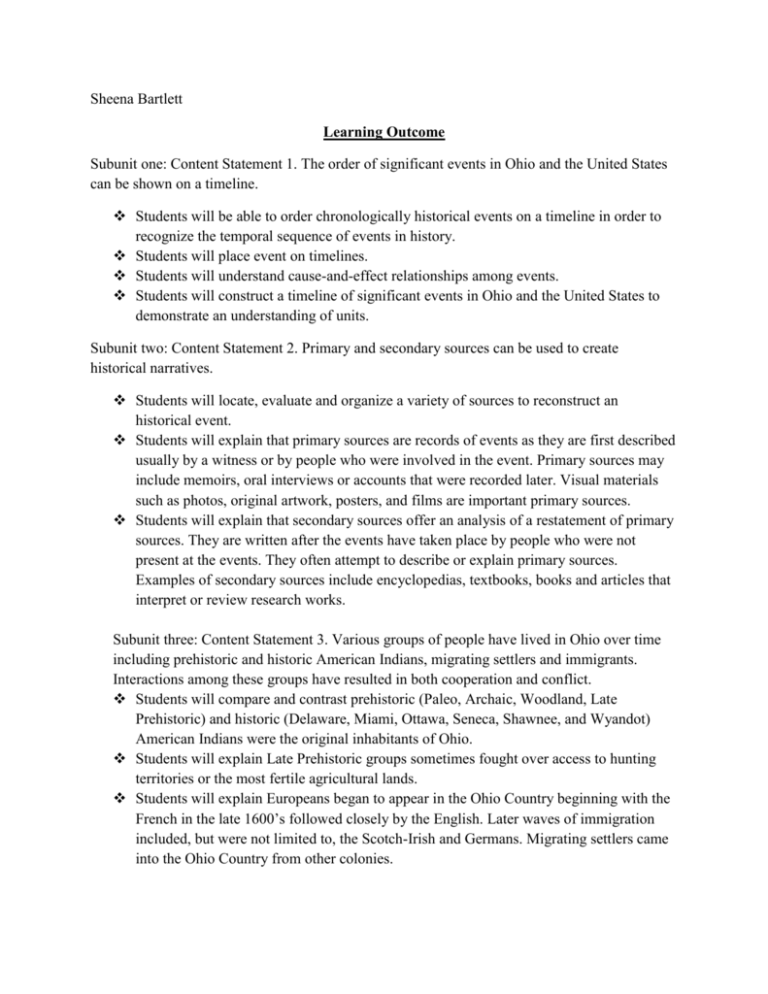
Sheena Bartlett Learning Outcome Subunit one: Content Statement 1. The order of significant events in Ohio and the United States can be shown on a timeline. Students will be able to order chronologically historical events on a timeline in order to recognize the temporal sequence of events in history. Students will place event on timelines. Students will understand cause-and-effect relationships among events. Students will construct a timeline of significant events in Ohio and the United States to demonstrate an understanding of units. Subunit two: Content Statement 2. Primary and secondary sources can be used to create historical narratives. Students will locate, evaluate and organize a variety of sources to reconstruct an historical event. Students will explain that primary sources are records of events as they are first described usually by a witness or by people who were involved in the event. Primary sources may include memoirs, oral interviews or accounts that were recorded later. Visual materials such as photos, original artwork, posters, and films are important primary sources. Students will explain that secondary sources offer an analysis of a restatement of primary sources. They are written after the events have taken place by people who were not present at the events. They often attempt to describe or explain primary sources. Examples of secondary sources include encyclopedias, textbooks, books and articles that interpret or review research works. Subunit three: Content Statement 3. Various groups of people have lived in Ohio over time including prehistoric and historic American Indians, migrating settlers and immigrants. Interactions among these groups have resulted in both cooperation and conflict. Students will compare and contrast prehistoric (Paleo, Archaic, Woodland, Late Prehistoric) and historic (Delaware, Miami, Ottawa, Seneca, Shawnee, and Wyandot) American Indians were the original inhabitants of Ohio. Students will explain Late Prehistoric groups sometimes fought over access to hunting territories or the most fertile agricultural lands. Students will explain Europeans began to appear in the Ohio Country beginning with the French in the late 1600’s followed closely by the English. Later waves of immigration included, but were not limited to, the Scotch-Irish and Germans. Migrating settlers came into the Ohio Country from other colonies. Students will explain that immigrants worked together to create new settlements in Ohio. They cooperated in building transportation systems and developing new businesses. Hunting strategies and agricultural practices were sometimes shared among American Indians and European settlers. On the other hand, issues surrounding the use and ownership of land caused conflict between these groups. Students will understand the continuing struggle among European powers for control of the Ohio River Valley resulted in the French and Indian War, which further strained relationships among the European settlers and the various American Indian tribes. Students will explain how interactions among prehistoric peoples and between historic American Indians and European settlers resulted in both cooperation and conflict. Subunit Four: Content Statement 4. The 13 colonies came together around a common cause of liberty and justice, uniting to fight for independence during the American Revolution and to form a new nation. Students will be able explain that the American colonies united in 1776 to issue the Declaration of Independence, announcing their decision to free themselves from Great Britain. They felt two practices of the British were particularly unjust because of high taxes were levied on stamps, paint, and tea without input from the colonists, who had no representation in Parliament, and the Proclamation of 1763 prohibited the colonists from settling west of the Appalachians. Students will explain that the colonists had to think of themselves as Americans and wanted to govern themselves. They the American Revolution to end British rule. During this time period, Ohio was developing as a populated frontier. Students will explain that Americans formed a new national government under the Articles of Confederation. Students will explain why the American colonists united to fight for independence from Great Britain and form a new nation. Students will be able to answer how do we know what really happened in the past. Subunit Five: Content Statement 5. The Northwest Ordinance established a process for the creation of new states and specified democratic ideals to be incorporated in the states of the Northwest Territory. Students will explain how Ohio progressed from territory to statehood, including the terms of the Northwest Ordinance. Students will explain how the Northwest Ordinance influenced the incorporation of democratic ideals in the states formed from the Northwest Territory. Subunit Six: Content Statement 6. The inability to resolve standing issues with Great Britain and ongoing conflicts with American Indians led the United States into the War of 1812. Victory in the Battle of Lake Erie contributed to American success in the war. Students will explain how the inability to resolve standing issues with Great Britain and ongoing conflicts with American Indians let to the War of 1812. Students will explain the significance of the Battle of Lake Erie to American success in the War of 1812. Subunit Seven: Content Statement 7. Sectional issues divided the United States after the War of 1812. Ohio played a key role in these issues, particularly with the anti-slavery movement and the Underground Railroad. Students will be able to describe the sectional issues that divided the United States after the War of 1812. Students will be able to explain the role Ohio played with the anti-slavery movement and the Underground Railroad. Subunit Eight: Content Statement 8. Many technological innovations that originated in Ohio benefitted the United States. Students will be able to identify important inventions in communication, technology and transportation that began in Ohio. Students will be able to explain how technological innovations that originated in Ohio benefitted the United States. Students will be able to answer how Ohio influenced the growth of the United States.

